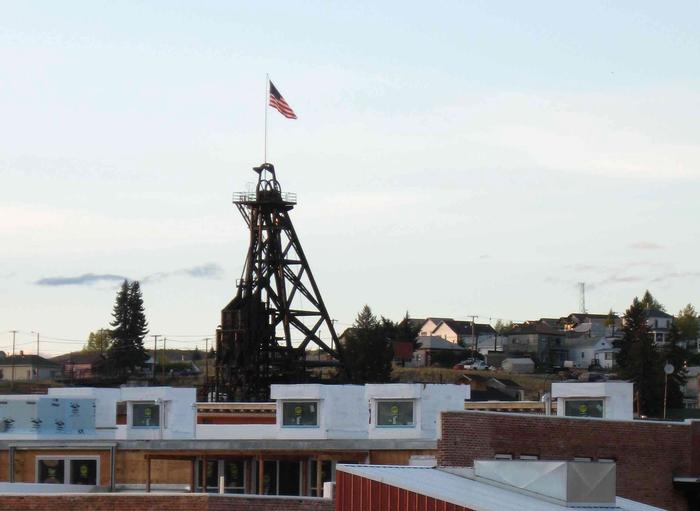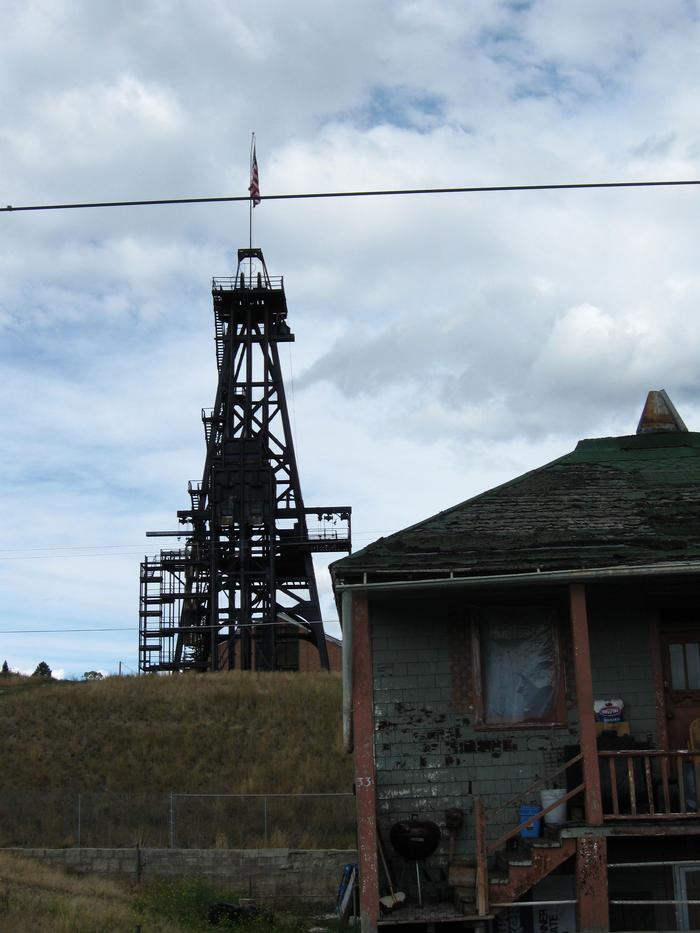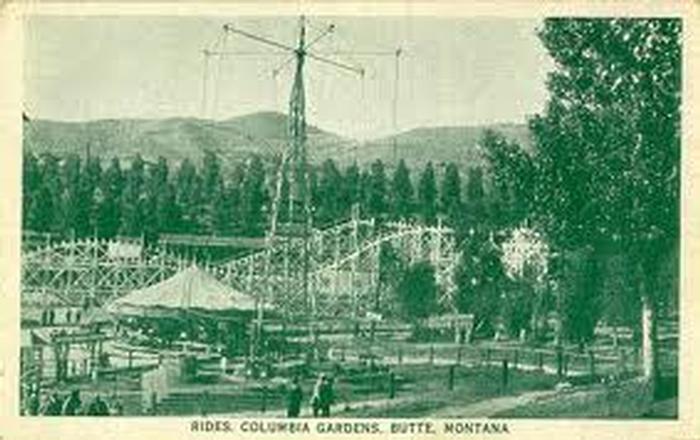[ID:145] The Locker Rooms At Anselmo Mine In Butte, Once Called Butte CityUnited States In the locker rooms at Anselmo Mine in Butte, once called Butte City, hang tags with the names of men who came to be claimed by the hoist and head frame. A sacred space is perhaps defined by its effect on those who enter. A great vastness that leaves us small, or an age that makes us young. Or perhaps a sacred place is so imbued with the memory of hardship our own hardship falls away; then the stillness of the space may be used as a remedy.
Such is the case in the locker rooms at Anselmo mine.
The town of Butte is known in Montana as a tired place past its prime, ravaged and exhausted both socially and environmentally by mining. The people are tired as well. This is what Butte is trying to recover from, and this is why there is a need for both celebration of heritage and a place of rest for the city.
Right now the mining complexes scattered throughout Butte are like a dead weight, a constant reminder, filled with negative connotations that are harmful to the town. A revitalization of the city is desired by everyone, but a shift in attitude is needed to embrace and overcome the ghosts of the past.
The opportunity for that shift, the catalyst for that change, exists at a place of ghosts: Anselmo.
Perhaps a sacred space is one in which we pass a threshold between here and elsewhere. We are suspended from the present, if only for a moment. Anselmo mine was never intended to be sacred or to be a place of beauty. It was thrown up in a hurry, like the dozen other mining complexes dotting uptown Butte and the surrounding hill, for the singular purpose of providing passage for the flood of miners who descended and ascended each day. It was built as a halfway house between above and below; now it is a threshold between the present and the past.
On the infrequent tours that are led through the complex, when a grizzled historian unlocks the chain-link and rolls the heavy gate aside, the sense of passing a threshold is as strong as that in a church. Here, the same hushed heaviness prevails. There is a somberness in the rotting doors, the rusted steel, and the way weeds have thrown themselves up around every wall.
Anselmo is one of the few mining sites that has not been at least partially leveled. The hoist-house still stands, filled with boilers and great reels of wire. The hundred-foot steel head frame that straddled Anselmo shaft now straddles only dirt, for the hole is filled in. The foreman's offices are a long building in poor condition, notable for the fact that they, for only a few high-ranking crew members, were larger than the entire locker rooms where hundreds of men changed. The foreman's offices were also heated, while the locker rooms were not.
Walking through this small complex, past the great bolted feet of the head frame and the wide hoist-house and sagging offices, it is the low, shadowy locker rooms which are most memorable. There are details here that the other buildings do not have. The place feels intimate.
In the Anselmo locker rooms, yellowed nametags of miners remain on many doors, and the dust on the floor appears thick enough to have been untouched since the day they left. The air is of a ghost town, a place that resonates with the memory of people. It is as though we might turn a shadowy corner and find ourselves face to face with a miner, with all his crew crowded whispering in the darkness behind him. There is a spirit about the place that is too precious to go unnoticed; this spirit, this haunting stillness, is the crux of a site that is key to Butte's history.
Men came here in hordes to be lowered beneath the city, to mile-deep arterial veins that both devoured and pulsed with miners. Here they emerged eight hours later, less men than eight hours before. Perhaps their friends removed the names of those claimed, or perhaps the tags of the dead were left hanging.
Regardless, the dust shivers. History thrums harder than the present. There are benches and grates where they showered, drains and hoses and pipes, and the dust and the grit, the rubble and filth, are the same they would have walked through. The tags do not tell who lived or who died but flutter, a silent memorial.
Anselmo is surrounded by residential districts of small mining houses, the tiny, modest type which spread across the hill during Butte's mining rush, when the head frames loomed above bustling neighborhoods and marked each mine as a center of activity. Now the little houses are sagging and covered with dust, and the mine at their epicenter is surrounded by chain link fence. The symbol of community has been cut off from the community, opened only a handful of times each year for brief historic tours. The neighborhood around the mine, which used to be the busiest and most hardworking, is now listless.
The closing of the mine shafts struck a hard blow to the city, because Butte grew a strong identity around its hardship. It was an identity defined by the things Butte fought against: Anaconda Copper Company, a huge mining conglomerate which controlled the economy but undervalued the workers. And mining itself, because the constant battle waged beneath the streets both claimed and allowed the lives of the miners.
If sites like Anselmo are left to weather away to dust, the record of hardships suffered– and therefore the record of the cause of Butte's pride– will be lost. In a town built on surviving, the past should not be fenced off from the people, because the memory of what Butte was should be lifted up and celebrated. Even though workers in Butte today have far less danger of dying, they have also lost the connection that came with that common danger. The town was once galvanized by fear of the mines and frustration with the Anaconda Copper Company. Now, with the loss of the source of their shared suffering, Butte could instead be united by an equally strong sense of pride. Revitalization will demand a huge change in the mindset of the people.
The catalyst for such change, however, could be quite small.
The site of Anselmo is a perfect such seed. A change in its connection with the surrounding residential district would signify a change in Butte's treatment of its heritage.
Currently, a road and walking trail pass within fifty feet of Anselmo. The road is not a main one, just a potholed track connecting two neighborhoods. The pedestrian path is not landscaped, merely a dusty ribbon threading its way uphill, speckled with the occasional historic marker.
Neither road nor path pause to consider Anselmo.
The place where they pass the site provides a panoramic view over Butte: the historic uptown, the scattered head frames looming above the roofs, and the sprawling new quarters around the interstate. From here it is clear there is a disconnect between the old and new in Butte. The town is filled with historic buildings and districts but the new city has grown downhill, sprawling away from the oldest part of town, away from the head frames and the old mining residential center. There is an increasingly distinct separation between the old and the new of the town that implies rejection of the old. But Butte, which takes its very identity from its mining history, would thereby reject itself.
Anselmo is also distinctly separated, by a chain link fence which divides it from the surrounding residential area and permits no approach. The future treatment of Anselmo should address this division of old from new, of the history of Butte from those living in Butte. Those walking on the pedestrian path see only the rear of the hoist house and locker rooms, but cannot step on the site or see inside the buildings. The revitalization of this neighborhood, and of the other neighborhoods which surround the other mine shafts, merely requires a way to make leftover remnants such as Anselmo a mark of pride.
From outside the fence, it is impossible to understand the sacred value of Anselmo. Only by entering, by stepping where the miners stepped, can the memory of the place be experienced.
As a future change, and a proposed improvement, fencing could be placed around individual buildings rather than the complex. It is important to protect the place from vandalism. But it is equally important to allow entrance for those who may benefit from that which is preserved– in this case the people of Butte, who could glean great strength from their heritage. A simple shifting of fence could give access through the site while still providing protection.
With fencing removed from the perimeter and located only around the base of each structure, the nearby walking path could then be incorporated into the site. All those passing by for the first or hundredth time could pause to consider Anselmo, peering through doors and windows and perhaps lingering long enough to read about and see photos of the history before continuing on their way.
A change of fencing to allow access and a redirecting of the walking path would allow Butte residents to pass through the sacred site of Anselmo and experience its stillness. But even more could be done, so that in crossing this threshold visitors could experience something beyond a simple revisiting of the past.
When mining was at its prime in Butte, and the Anaconda Copper Company was thriving, the Company built a community park called Columbia Gardens, with green space and rides. Children would flock there just to lie on the grass, because with all the mining and industry in Butte vegetation was nearly unheard of. The Gardens were sponsored by Anaconda Copper Company as a way of giving back to and fostering goodwill within the community.
Columbia Gardens became a symbol of the good side of life in Butte, of the tight-knit community that grew up around the hardship of the mines.
In the early twentieth century, Anaconda Copper Company began struggling, and the huge open mine called Berkeley Pit was expanded in a desperate attempt to salvage the mining economy of Butte as well as save the Company from bankruptcy. Berkeley Pit grew until it began consuming nearby neighborhoods like Meaderville one by one. The people of Butte had no choice but to watch parts of their town be demolished, because the alternative was the end of mining.
Berkeley Pit spread until it was at the edge of Columbia Gardens. And then, one night, the Gardens burned, and the fire spread so fast no part of the park could be saved. This was a heavy blow to the town; there were whispers of arson, that the fire had been started by the Company as a means of getting rid of the Garden, but no one dared speak that out loud.
A few years later, Anaconda Copper Company went bankrupt. Mines closed. Today Berkeley Pit, which expended to destroy neighborhoods and the plot of ground that held Columbia Gardens, is now a toxic lake slowly filling with acidic water.
Vegetation and green space is still rare in Butte.
When grass and trees existed at Columbia Gardens, they designated a site which had been reclaimed for the people, taken away from mining and used as a park. The Gardens was an oasis, a place of respite. Perhaps, in its own way, sacred. It helped the people cross a threshold and briefly transported them away from the hardships they faced, reminding them of the good reasons to live in Butte: a fitting task for a sacred space in this town, and one which could still be aspired to.
Columbia Gardens burned and was demolished because of the expansion of a mine. Now, at Anselmo, a small, landscaped park could be coaxed into life between the old structures.
The same could happen at other mine sites, where other head frames and hoist houses and locker rooms are fenced off to prevent entrance. If every one of these perimeter fences was removed and replaced with fences close to the historic structures, dozens of dusty patches of ground could be opened up and cultivated. These spaces are currently designated as off-limits because the existing historic structures mark them as undevelopable. With a simple unfencing and refencing, every old mining structure could instead be used to signify space for community.
Anselmo could become the first of many reclaimed places, followed by the successive unfencing of other sites, the rediscovering of other buildings like the locker rooms, an acknowledgement of other sacrifices, as seen in the locker room name tags.
If a sacred space may be defined by its effect on those who enter, then Anselmo mine is a shrine within Butte, with great potential for social influence. A simple change in fencing and redirecting of the walking path, to allow people to draw near and pass through history, would signify the much greater change which is sought in Butte: the lifting up of the past. The reclamation of the ground with landscaping would transform existing mine structures into the mark of a park for the people.
The structures of Anselmo- the looming head frame, the silent buildings, and the rows of nametags on twisted wire fluttering in the locker room - hold a sacredness that stems directly from the struggles of the town. Butte is in need of a resting place; here, far from the freeway, at the changing rooms between above and below, the living could be approached by those who lived.
Works Cited
Malone, Michael P. The Battle For Butte: Mining and Politics on the Northern Frontier, 1894-1906. University of Washington Press: Seattle, 1981.
Freeman, Harry C. A Brief History of Butte, Montana. Henry O. Shepard Company Printers: Chicago, 1900.
If you would like to contact this author, please send a request to info@berkeleyprize.org. |



